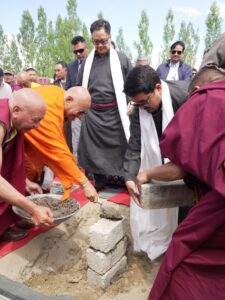Last Updated on December 11, 2020 at 12:48 pm
Pashmina has largely contributed to the economics of Ladakh and is deeply connected with its history. Kashmiri artisans, traders and merchants have attracted the attention of the world by their fine fabric with their exquisite finished products like shawls and other apparel.
The raw material which is used in making of this fabric is collected from the famous Changra goats which are found grazing the high pastures of the Changthang region which is located 14,000 feet above sea level in East-Southeast Ladakh, and also in the highlands of Western Tibet. the Changpas, an agro-pastoralist community, rear these goats. Also Read: Ladakhi mason who led the construction of airfield in 1961
The modern history of Ladakh and its relation with Pashmina dates back to 1684 when Treaty of Tingmosgang was signed. It was a tripartite agreement between the Mughals, the then King of Ladakh and the Tibetan kingdom. The treaty stated that Kashmiri traders would enjoy exclusive rights to purchase pashmina from Ladakh.
As the Mughal Empire disintegrated, the region of Ladakh began to exercise some sense of independence, but pashmina trade continued to take place in line with the treaty. However in 1834, the legendary Dogra general, Zorawar Singh, initiated vicious military campaigns in Ladakh with an aim to control the pashmina trade.
Zorawar Singh’s campaign butchered any aspirations of an independent Ladakhi kingdom. The Dogras were obedient to the Sikh empire. When Ladakh faced defeat from the Dogras, the then royal prince of Ladakh and his third wife went to a British protectorate and asked for their help.
Unfortunately, Britishers had signed a treaty with the Sikhs in 1809. It was agreed in the treaty that Punjab would defend the region controlled by East India Company from the Afghans. In return for the Sikhs defense, British promised that they would not interfere the region which is north of the Sutlej river. However, later in the course of history, Britishers gradually took control over all the parts of India.
The Indian Government is trying to revive the economy of Ladakh by encouraging micro-small and medium enterprises. Many ventures are setting up in the region to produce finished products of pashmina as they yield higher monetary benefits. There is a hope that the trade of pashmina can boost the local economy as it used to do in past.



